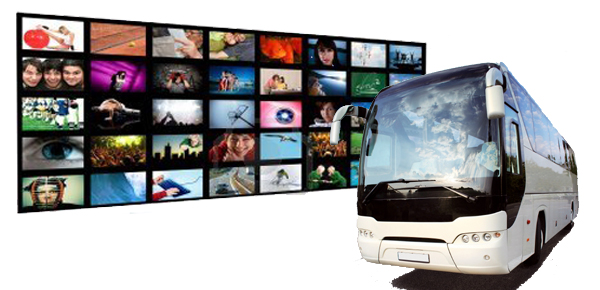Three are the main factors which define the different individual entertainment Systems available in the market:
- The type of contents they offered ( lineal or Video on Demand )
- Type of technology ( Ethernet, radiofrequency or wireless).
- Size of the Screen 7”, 9” ( most common) or 10”.
In this article we will discuss in detail each of these factors which are vital in order to select the best onboard individual entertainment system.
Contents: Video on Demand and lineal systems
The type of contents offered is the key factor of all the on board entertainment systems. The Video on Demand systems allow the passengers to select the type of contents they want to enjoy by interacting with a touch screen. The basic offer includes movies, music, radio, e-books and games. The passenger decides when he wants to interact with them being able to move forward –backward and stop a movie for example.
Other options that can be included in order to enhance your on board entertainment offer are the Satellite Live TV (installing a satellite antenna with its decoder) or the Internet access ( installing a professional router with enough bandwidth for the interaction of the passengers). If we decide to offer internet it´s very important to use capacitive screens (they allow to make zoom using the fingers), besides a modern version of Android is required to deal with the graphic applications like Flash.
The lineal Systems offer a number of simultaneous channels accessible by the passenger using +- pushbuttons. In every single channel we could enjoy a different content: movie, channel tv, music, radio… The broadcasting of each channel is fix reason why the passenger can´t change the broadcasting options.
Type of technology of the data transmission
The type of technology used for data transmission is a very important factor that transcends the purely technical level, we distinguish several types: Wifi System (ie, completely wireless), Wired System and Radio Frequency cabling technology.
- The Wireless System- WIFI is the easiest system to install. It uses a type of tablet display with plenty of graphics and applications available and it´s just necessary to give them 24V power supply. Besides that they have less chance of failures of the system and more flexibility, for example if we want to move a seat or make a seat refitting we just need to change the power supply cable.
- The Wired System requires a more complete installation because every single display needs its own data cable, increasing enormously the failure points of the system. The main advantage of the systems is its software management because just modifying the software in the central server the changes are applied to all the displays. In a wireless system the modification has to be done in every single display.
- The Radio Frequency Wired System is just used by the lineal Access Systems. It´s not a digital transmission, it´s analogical ( video+audio ). The wire install in the bus is coaxial, we basically distribute individual video to every single screen.
Size of the Display : 7” or 9”
The most common sizes are 7 “and 9“, and not by chance. The seats of buses or coaches usually allows the installation of 7 “on their backside , while 9” displays require more space . The distance between the eyes of the passenger and the display is suitable for 7 “and 9″. For configurations with short distance between seats, to prevent the front passenger reclining display is very close, it is advisable to install 7. ”
Some manufacturer presents displays 10 ” for Asian and South American markets due to the use of large armchairs in those markets where the distance between the passenger and the screen is enough. You do not have chance in Europe, except in special vehicles.
After reviewing each of these three factors only raise one more.
After reviewing each of these three factors only raise one more question: how to choose the right one? In addition to the technical issues that we have noted in this article, we must also take into account the economic side, just a example: if we assume that the most expensive system (Wired Ethernet) costs 100 €, a wireless system would cost de75 € -80, and RF cabling a cost of 60-65 €.
